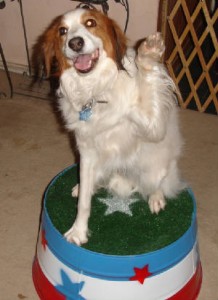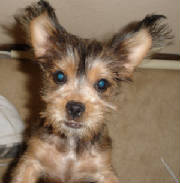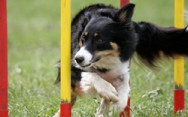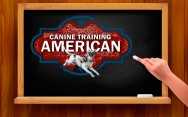Articles
Home -
Articles posted by LimeCuda
 Potty training your puppy can be one of the most challenging aspects of his education. Unfortunately, there truly is no magic wand and the only way to effectively teach your pup to where to eliminate is through consistency.
Potty training your puppy can be one of the most challenging aspects of his education. Unfortunately, there truly is no magic wand and the only way to effectively teach your pup to where to eliminate is through consistency.
Potty training can be viewed as a two phase process. In phase one, teach the pup where you want him to go and in phase two teach him where you don’t want him to go. The phases are not mutually exclusive which means that you can and should implement both phases at the same time.
In order to facilitate potty training it helps to understand several basic concepts:
1. If you control what goes in, you control what comes out.
Try and feed your puppy on a schedule. Many puppies have to eliminate 30 seconds to 30 minutes after they eat so if you know what time your dog eats you can probably predict what time he’ll eliminate. Unless your vet recommends it to prevent hypoglycemia, avoid free feeding in which food is left down all day for the dog to eat when ever he wants. Put the food down and leave it down for fifteen minutes. Then pick up whatever is not consumed. Your dog will learn that if he doesn’t eat it while its there it goes away. This also helps to prevent finicky eating and allow you to control your dog’s weight.
Offer the dog water several times a day and do not allow him to suck down massive quantities of water needlessly. The more water he has in his bladder the more he’ll have to pee.
*
2. Dogs repeat rewarded behaviors.
Another key to successful potty training is remembering a key concept regarding dog training in general: Dogs repeat rewarded behaviors. Soiling in the house is one of the most rewarding things your dog can do because if he’s a little uncomfortable and he relieves himself on your rug he feels better. Make soiling in the wrong place unrewarding by catching him in the act and interrupting the dog while he’s doing it. Then take him where it is acceptable and reward him for eliminating there.
*
3. It’s easier to prevent a bad habit than to fix one once it’s started.
Confine and supervise your puppy 24/7 until he’s potty trained. Use a crate to create a den-like haven which he should be less inclined to soil. If you’re not watching him he should be confined, and if he’s not confined you should be watching him.
TAKE YOUR PUP OUT FREQUENTLY DURING THE DAY!!! That way you prevent him from going to the bathroom in the wrong place and control his going in the right place where concept number two can be implemented. He’ll probably have to potty after sleeping, eating, playing, etc and the more times he potties where you want him too the less times he’ll potty where he shouldn’t.
For Complete Dog Training visit: American Canine Dog Training and Dog Boarding In Las Vegas
CLICK HERE FOR: STEP BY STEP POTTY TRAINING
Den Training Advice from Las Vegas Dog Trainer, Carol Frisby
Don’t “Cage” your Puppy
Not long ago, I saw a comic strip of a smug looking dog telling a crestfallen looking cat that the reason people don’t keep cats on leashes is because they want cats to run away. It’s a favorite cartoon of mine except that in the edited version in my mind, the dog (complete with its superior expression) is in a crate. Curiously, while most people would never allow an unsupervised, un-diapered infant to crawl around outside of a play pen, many pet parents still just can’t spin the concept of crating – which is the canine equivalent – to the point where it works for them. Therefore, I encourage them to explore Den-training.
to run away. It’s a favorite cartoon of mine except that in the edited version in my mind, the dog (complete with its superior expression) is in a crate. Curiously, while most people would never allow an unsupervised, un-diapered infant to crawl around outside of a play pen, many pet parents still just can’t spin the concept of crating – which is the canine equivalent – to the point where it works for them. Therefore, I encourage them to explore Den-training.
Simply put, den training is based on the theory that dogs are “den” or “denning” animals. All that means is that dogs are actually instinctively programmed to like small, dark, cave-like places or dens that they can use as safe havens. Den training means that the dog learns to accept being confined in a den whenever the doggie parent says so. By the way, denning doesn’t have to mean using a crate. A barrier, or baby gate in the doorway of a bathroom or other small room also works well. Now, if the denning instinct is never actually called upon when a dog is young, it may disappear and trying to teach some dogs that using a den is a good idea can be a challenge. Most dogs however, when properly trained actually love their dens and return to them frequently and willingly on their own.
So, lets get to why we should den train. A key concept in understanding and influencing dogs is that dogs are “in the moment” creatures. Basically, if we want to teach a dog that we do or don’t want him to do something, the easiest way is to catch him in the act of whatever it is. Then we can reward him if we want the behavior, or correct, or redirect him if we don’t want the behavior. As a general rule, dogs (and a great many other living creatures for that matter) tend to increase rewarded behaviors, and decrease unrewarded or corrected ones. So, in order to get Fido trained, we have to react to each and every thing he does until he learns what’s okay and what’s not. Remember, we can should also act to prevent him from doing things we don’t want.
That means that the dog should be either confined or supervised constantly until he learns the rules. By teaching the dog to den on cue, we actually control almost all of the dogs behaviors so that we can reward the ones we want and prevent the ones we don’t want. For example, a denned dog can’t chew up the leg to your coffee table while you’re out. He can’t chew it up because he can’t get to it of course, but if he attempts to chew it up while you’re watching him you can correct him or redirect the chewing to an appropriate object.
Another advantage to den training is that it often helps with potty training. Dogs are programmed not to soil their dens and confining them and letting them out on a schedule can help prevent accidents.
Also useful for getting a dog on the right track is the idea of setting them up to be successful. We want our canine buddy to get stuff right as often as possible and using a den really helps with that. If you head out for a bit and when you get home your house is in shambles, your reaction to Fido may not be very warm and loving. However, if you head out for an hour and leave your dog in his den, when you get home, he’ll be happy to see you, and rather than spending time cleaning up a mess and greeting him with anger, you’ll be able to let your dog out immediately and spend quality, positive bonding time with him. Denning also keeps Fido from injuring himself by preventing him from eating things that may be harmful, or from becoming trapped behind wall units or entangled in electrical wiring etc.
So change the way you look at the concept of confining your dog! You may find it’s just the ticket for ensuring a safe, happy, well adjusted buddy!
Coming soon…the steps to den training.
How To Teach Your Dog To Wave or “hi five”.

Step One:
Get your dog sit on your command .
Step Two:
Teach your dog to ‘touch”. When the dog is sitting, hold a treat over the ear opposite the leg you want to lift. ie. While facing the dog hold a treat over his right ear to pick up his left paw. That takes the weight of the leg you want and makes it easier for the dog to offer you his paw. If he does not readily pick up his paw, tickle the hair behind the “knee” until he does. Don’t grab at his leg…many dogs don’t like having their feet touched, so be sure he picks the paw up on his own and then just let it rest on your hand with your palm up and your fingers pointing towards the floor. When the dog consistently touch’s your palm add any command you want like, “say hello”, or “touch”, or “gimmie five”.
Step Three:
When the dog is consistently putting his paw in your hand on command, leave your palm flat and open and start to raise your hand a little so he has to reach up to touch your palm. Then turn your hand so your fingers are upward as in ‘High five”. When he consistently reaches to touch your palm add any command you want to use.
Step Four:
Hold your hand high enough for the dog to have to stretch, but not so high that he’ll jump or break the sit. Gradually add distance between your hand and his paw until you’re just standing in front and he picks up his paw and waves. Add the verbal command wave or what ever word you want to use.
If you are looking for Dog Training Or Dog Boarding in Las Vegas area please feel free to contact us.
HOW TO TEACH YOUR DOG TO “SIT”
Sit means put your tail on the floor until you’re released or given something else to do.
Use a food lure directly in front of your dog’s nose and slowly move upwards over his head. If he sits, say good and give him the food.
Don’t add the command until the behavior is consistent (until the dog sits every time you hold up the food) he doesn’t know what the word means anyway.
When the behavior is consistent, add the word AS THE DOG IS PERFORMING THE BEHAVIOR so he can link the two in his mind. This helps keep you from having to repeat commands. Then add the command before the behavior. Don’t forget the positive word marker every time! See: “The Stuff You Gotta Know”
When you add the command before the behavior you can also add the release words “lets go“ to indicate that the dog can get up. See “Release Words” Keep sits very short at first so the dog learns to listen for the release and then gradually add time. If he gets up DO NOT REPEAT THE COMMAND. Use the negative word marker, lure with food or reposition and then say “good“.
HOW TO TEACH YOUR DOG TO “DOWN”
Down means lay in place until I release you or give you something else to do. The place can be the floor, or a specific blanket, or a dog bed or in a spot at your feet.
Down is used to keep the dog quiet and under control in a relaxed position while you do other things.
To teach your dog the down command, start with the dog in the sit position. Use a food lure directly in front of the dog’s nose, no further than ½ inch away, and slowly move the treat down between the dog’s front paws. Do not move your hand forward away from the dog. Remember to go straight down SLOWLY between his front paws. You won’t need to add the command down until the dog is consistently and quickly following the treat into the down position every time. You can let the dog lick and nibble at the treat every time his head follows it down a little at first until he figures out that he has to keep his tail down and then put his head down at the same time. As soon as his chest is on the surface, say good and give him the treat.
If he gets up at the point, its o.k. Don’t scold or correct him, just start the exercise again.
If he does not get up, release him (see release words) and give him another reward.
When the dog downs consistently and quickly, go ahead and add the word just as his chest hits the surface so he can associate the word with the action. Palm the treat in your hand for just a second, give the release word, and reward. Do not say “Stay”. Stay is used to indicate that you’re going to add distance or duration and is confusing to the dog and unnecessary.
If he gets up before you release him, simply return him to position until he learns he has to wait for the release word before he can get up.
Hope you are able to teach sit commands to your loving Dog, If not, you can certainly contact us for Dog Training in Las Vegas we are one of reputed dog trainers and dob boarding owners in Nevada.
Dogs repeat behaviors based upon the consequences of the behavior.
If a dog does something and the consequences are pleasant the dog will consider the behavior rewarded and repeat it. DOGS USUALLY REPEAT REWARDED BEHAVIORS.
Rewards can be food treats or life rewards. Life rewards are things that occur on a day-to-day basis that your dog is willing to work for, like dinner, attention, praise, walks, games, car rides etc.
If a dog does something and the consequences are not pleasant the dog will most likely not repeat the behavior. DOGS USUALLY DROP BEHAVIORS THAT ARE NOT REWARDED.
The fastest way to train a dog is to consistently reward the behaviors you want and to consistently correct (or not reward) the behaviors you don’t want.
Remember, dogs also develop “self-rewarded” behaviors which have pleasant consequences or rewards that don’t necessarily come from you. Relieving his bladder on the carpet makes the dog feel better and is therefore rewarding for him and may be repeated if you’re not vigilant. Chewing up your remote control may be lots of fun for your dog and therefore could be perceived as rewarding for him and repeated – especially if you’re not around to be either more rewarding or to make chewing the remote unpleasant.
Corrections (or aversives) can be time outs, squirts from a water bottle, loud unpleasant sounds, ignoring the dog or leash corrections among other things.
Dogs Aren’t Born Knowing What We Want.
If the dog does something you want, let him know he got it right by saying good and rewarding him. The word “good” is called a “positive word marker”.
If he does something you don’t want say “uh-uh” or “no” and re-direct the behavior or correct the behavior and then say good when he’s right. The sound “uh-uh” or the word “no” are called “negative word markers”.
When you give your dog a command like “sit”, “down”, or “stay” be sure he remains in the position until you give him his “release word”. The release word tells the dog it’s all right to stop doing what you’ve asked for. Avoid common words for release words like “o.k” that the may mistake for a release.
Reasons Dogs Don’t Do What We Want Them To Do.
He Didn’t Hear
Dogs have excellent hearing. Generally, if a dog doesn’t do what we want it’s not because he didn’t hear us. However, be sure to speak clearly when communicating with the dog.
He Wasn’t Paying Attention
Be sure the dog is focused on you before you ask for something. Get his attention by saying his name first.
He Physically Can’T Do What We Want
If the dog is on the patio and the door is closed he cannot come when called.
Yorkshire Terriers cannot pull drowning victims to shore. They’re physically too small.
He Doesn’t Understand What We Want
Say what you mean, and mean what you say. Teach the dog what you want by showing him, and then repeating the steps until he can remember them. Use one word commands. “Sit down” is a very confusing command for a dog.
He Just Doesn’t Want to do What We Want
THIS IS THE BIGGIE!!!!
Teach the dog that it is in his best interests to do what we want by using rewards and corrections consistently.
If you are looking for Dog Boarding In Las Vegas and Dog Training of any breed in Las Vegas we appreciate to reach us for the same.
Group dog Classes Are Happening Now. Click the “calendar” link for upcoming dates in Summerlin and Town Square!
 Potty training your puppy can be one of the most challenging aspects of his education. Unfortunately, there truly is no magic wand and the only way to effectively teach your pup to where to eliminate is through consistency.
Potty training your puppy can be one of the most challenging aspects of his education. Unfortunately, there truly is no magic wand and the only way to effectively teach your pup to where to eliminate is through consistency.





















